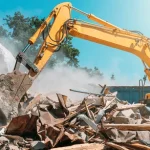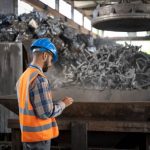Metal Recycling: The Untapped Potential of Scrap Metal
In Australia, where sustainability and resource management are becoming increasingly important, metal recycling is an essential component of waste management. Metals, such as steel, aluminium, and copper, are among the most valuable and widely used materials in the world, and the process of metal recycling helps conserve natural resources, reduces environmental pollution, and contributes significantly to the economy. However, despite these benefits, metal recycling remains an untapped resource. In this article we explore the economic and environmental advantages of metal recycling, including the different types of metals that can be recycled, and how the metal recycling process works.
The Economic Benefits of Metal Recycling
The economic benefits of metal recycling are compelling. By diverting scrap metal from landfill, industries can access a cost-effective source of raw materials. This reduces the reliance on virgin ore extraction, which is often energy-intensive and environmentally disruptive. As an example, recycling aluminium consumes far less energy than extracting aluminium from bauxite ore. The cost savings associated with reduced energy consumption and raw material acquisition are substantial, contributing to the competitiveness of industries that utilise recycled metals. Moreover, the scrap metal industry itself generates employment opportunities, from collection and sorting to processing and distribution, and the trade of scrap metal, both domestically and internationally, also contributes to the national economy. Therefore, promoting strong metal recycling practices is not only an environmental imperative but a sound economic strategy.
The Environmental Advantages of Metal Recycling
The environmental benefits of metal recycling are equally profound. Extracting and processing virgin metals generates significant greenhouse gas emissions and contributes to soil and water contamination. Conversely, recycling metals substantially reduces these environmental impacts. Aluminium recycling, for instance, can reduce energy consumption by up to 95% compared to primary production, resulting in a corresponding decrease in greenhouse gas emissions. Steel recycling also plays a crucial role in reducing the need for iron ore mining and the associated environmental degradation. Furthermore, recycling diverts scrap metal from landfills, minimising the potential for soil and water pollution from the leaching of hazardous substances. By embracing comprehensive metal recycling initiatives, Australia can significantly reduce its environmental footprint and move towards a more sustainable future.
The Types of Recyclable Metals
A wide range of metals can be recycled, each with its own unique properties and applications. Aluminium recycling is particularly prevalent, given its widespread use in packaging, construction, and transportation. Steel recycling is equally important, as steel is a fundamental material in infrastructure and manufacturing. Copper, brass, and bronze are also valuable recyclable metals, which can be found in electrical wiring, plumbing fixtures, and machinery. Other recyclable metals include lead, zinc, and tin. Knowing the diverse types of metal and their respective recycling processes is important for maximising resource recovery and minimising waste, and the Adelaide Waste and Recycling Centre processes most of these types of metals.
The Metal Recycling Process
The metal recycling process plays an important role in sustainable resource management, transforming discarded metal items into valuable raw materials. Here’s a breakdown of the key stages involved in metal recycling:
1. Collection and Sorting:
- Collection:
- This initial phase involves gathering scrap metal from diverse sources, including households, industrial sites, construction and demolition debris, and end-of-life vehicles.
- Scrap yards, recycling and refuse centres like ours play a vital role in this stage, providing drop off points and sometimes offering compensation for delivered materials.
- Sorting:
- The collected metal is then sorted based on its type. This is essential because different metals require distinct processing methods.
- Sorting can be done manually or using automated technologies like magnets and sensors.
2. Processing:
- Crushing and Shredding:
- Large metal items are reduced in size through crushing and shredding. This increases the surface area of the metal, making it easier to melt and process.
- Hammer mills and shredders are used to break down the metal into smaller, manageable pieces.
- Separation:
- Further separation may be necessary to remove impurities and non-metallic materials, such as plastics, rubber, and insulation.
- Techniques like magnetic separation, air separation, and eddy current separation are employed to achieve this.
3. Melting and Purification:
- Melting:
- The sorted and processed metal is then melted in large furnaces. The specific furnace and temperature depend on the type of metal being processed.
- This stage transforms the scrap metal into a molten state, ready for purification.
- Purification:
- The molten metal is purified to remove any remaining impurities and ensure the quality of the final product.
- Electrolysis and other refining processes are used to achieve the desired purity levels.
- The addition of other alloys may also take place at this point, to create specific metal types.
4. Solidification and Shaping:
- Solidification:
- The purified molten metal is then cooled and solidified.
- This can be done by pouring the molten metal into moulds to create ingots, billets, or other shapes.
- Shaping:
- The solid metal can then be rolled into sheets or formed into other desired shapes, for use in manufacturing new products.
Metal Recycling – In Conclusion
Metal recycling represents a significant opportunity to achieve both economic and environmental sustainability. By diverting scrap metal from landfills and transforming it into valuable raw materials, Australia can reduce its reliance on virgin ore extraction, minimise greenhouse gas emissions, and create employment opportunities. Through continuous promotion, innovation, and investment in recycling technologies, we can ensure that metal recycling plays a central role in Australia’s transition to a circular economy.
Adelaide Waste and Recycling Centre
Our friendly operators are available at the AWRC if you need to clarify any further information.


